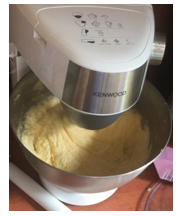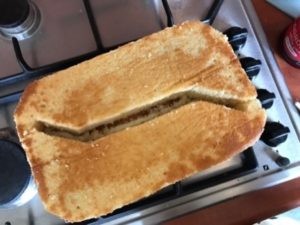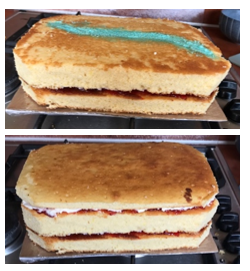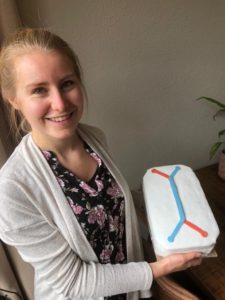For successful Organ-on-Chip research, combining multiple areas of expertise is crucial. Even though there is constant feedback from one to the other discipline, in practice, they are very different: a biologist spends most of the day nourishing and photographing cells, while an engineer is busy designing new platforms and sensors. As the COVID-19 pandemic forces us to be a bit more creative with our time, I (a biologist) thought this was the perfect opportunity to step out of my ‘biology bubble’ for a while and enter the world of chip fabrication. Well… in my own way. And since we need to cope with the pandemic for a little longer, I decided to share these efforts and the recipe, for other Organ-on-Chip enthusiasts who have some time to spare.
Step 1. The Matrix: Mixing, Casting & Curing
Pre-heat the oven to 180 °C. Cover the inside of a baking tray (~20 x 30 cm) with baking paper. Mix butter (400 g, room temperature), sugar (600 g), vanilla extract (3 tsp) and salt for several minutes until creamy. Add eggs (8) one by one, while mixing. Take another bowl to mix flour (600 g), cornstarch (90 g) and baking powder (3 tbsp) and add halve of this flour-mixture to the butter-mixture, then add buttermilk (250 ml). Repeat with the other halve of the flour-mixture and another 250 ml of buttermilk. Finally, add some lemon zest and fresh lemon juice to the mixture. Pour 1/3 of the batter in the baking tray and bake the cake in 30-35 minutes until golden brown. Repeat this twice to make three cakes in total.
Step 2. Shaping the Layers
 Let the cakes cool to room temperature and cut the layers to three equal rectangles.
Let the cakes cool to room temperature and cut the layers to three equal rectangles.
Then cut off a small part of the corners. Take one of the cake layers and cut out a small ridge in the middle of the cake to form a (micro)channel using a template. (Don’t forget the inlet and outlet ports in the top layer, as I did!)
Step 3. Alignment & Bonding of the Layers
In a bowl, whip cream (250 ml), sugar (30 g) and stabilizer (8 g) until peaks form. Take halve of the whipped cream and add blue (or other color) food coloring.
Take an intact cake layer and cover with a layer of strawberry jam and then whipped cream. Position the cake layer containing the channel on top. Fill the channel with colored whipped cream. Then cover the entire layer with strawberry jam and whipped cream and position the final cake layer on top.
Step 4. Coating the Chip
Roll out blue and red fondant to a thin layer. Using a template, cut out a (micro)channel. Roll out white fondant to the size that it can cover the entire cake.
 Mix butter (100 g) with powdered sugar (100 g) and cover the layered cake with a thin layer of the mixture for the fondant to stick. Carefully place the thin layer of white fondant over the cake, fold at the edges and cut the residual fondant away. Using the butter-sugar mixture, add the red and blue fondant channels on top of the cake.
Mix butter (100 g) with powdered sugar (100 g) and cover the layered cake with a thin layer of the mixture for the fondant to stick. Carefully place the thin layer of white fondant over the cake, fold at the edges and cut the residual fondant away. Using the butter-sugar mixture, add the red and blue fondant channels on top of the cake.
Enjoy!
Renée Moerkens, NOCI PhD-student at UMCG
 Update: In the meantime, a second version of the Organ-on-Chip cake was made by Heleen Middelkamp NOCI PhD-student from University of Twente
Update: In the meantime, a second version of the Organ-on-Chip cake was made by Heleen Middelkamp NOCI PhD-student from University of Twente
